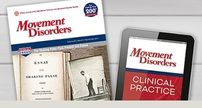Tics & Tourette Syndrome
Clinical Overview
Tics are brief movements or sounds that resemble voluntary actions, but appear suddenly, without regularity, often exaggerated in intensity and are repetitive and inopportune to social context. Tics also lack behavioral flexibility, which is a characteristic marker for voluntary actions and defines normal human goal-directed behavior. Both motor and vocal (or phonic) tics can be highly variable within and between individuals and indeed any possible movement or sound can be a tic. Hence, among the spectrum of hyperkinetic movement disorders, tics have the widest phenomenological variability.
On grounds of phenomenology, tics are classified into simple motor (e.g. blinking, eye rolling) or vocal (simple sounds as “ah”, “uh” or grunts, coughs, throat clearing, hissing sounds etc.), when they involve specific effectors of one body part or present with isolated vocalizations. Complex tics refer to motor or vocal behaviors that appear patterned, as for example gestures (e.g. flailing both arms as if waving goodbye or clapping hands) or complete words or even sentences (e.g. ‘hello’, ‘mango salad’, ‘have a nice day’ etc.). Motor tic behaviors are most often clonic (i.e. brief, abrupt and rapidly occurring), but some tics may be tonic (i.e. isometric muscle tensing) or dystonic (leading to - somewhat - prolonged abnormal postures). The rubric of complex tic behaviors also encompasses three further phenomena: echo-, pali- and coprophenomena. Echophenomena denote the imitation of movements (echopraxia) or sounds (echolalia) from the surrounding environment, which often occur in the absence of explicit awareness. Paliphenomena refer to the repetition of actions (palipraxia) or sounds (palilalia). Coprophenomena describe the occurrence of obscene gestures, including writing, or vocalizations that occur without intent.
View complete description
Tics have two additional distinctive features. First, they are often preceded by an unpleasant sensory experience, most commonly labeled as “premonitory urge”. Akin to interoceptive experiences, patients typically have difficulties providing exact accounts of premonitory urges, often using terms as “itch”, “burning”, “muscle tension” or “the need to perform a tic” to describe them. Usually, the execution of a tic behavior provides temporary relief from the impeding premonitory urge. Second, tics can be voluntarily suppressed for brief periods of time. Indeed, both the presence of premonitory urges and the capacity to effortfully suppress tic behaviors on demand are helpful clues in severe cases, where the distinction from other hyperkinetic movement disorders, as for example, chorea may be difficult.
Tics can be encountered in a wide range of neurodevelopmental, neurometabolic and neurodegenerative disorders. However, in the clinical setting are most commonly seen in Gilles de la Tourette syndrome (or just Tourette syndrome: TS). According to DSM-5, TS is defined by the presence of at least two motor tic behaviors and one vocal tic behavior for a minimum period of a year, manifesting before the age of 18. Other primary tic disorders include chronic motor and vocal tic disorder – defined by the presence of either motor or vocal tics as isolated manifestations -, and provisional tic disorder, when tics have been present for less than a year. It is noteworthy, that in the majority of cases with TS, patients will also present with a wide range of neuropsychiatric comorbidities. These include attention-deficit hyperactivity disorder (ADHD), obsessive compulsive behavior/disorder (OCB/OCD), depression, anxiety disorder, self-injurious behavior and others. Importantly, the range of clinically relevant comorbidities in a given individual may change with time. For example, depression and anxiety disorders become more prominent in adults with TS, as opposed to young children, where ADHD might often be a core clinical issue.
As with any disorder, but more so with tics, treatment already begins at the time of diagnosis. This means that in the majority of cases explaining the neurobiological background of the disorder and the spectrum of associated phenomena and comorbidities might suffice. Moreover, in many cases a prioritization of treatment goals could point towards interventions aiming to reduce the impact of comorbidities such as ADHD, OCD or depression. However, when tics are harmful or socially disturbing, therapeutic venues, including behavioral and pharmacological are necessary. Within the spectrum of available pharmacological treatments, two different classes of medication, a2-adrenergic agonists and antipsychotics are primarily recommended.
Clonidine and guanfacine are a2-adrenergic agonists, with proven efficacy particularly in cases with comorbid ADHD. Gradual titration and careful monitoring are necessary for possible side-effects, including hypotension, bradycardia, dizziness and headache. Also, caution needs to be exercised in the case of treatment discontinuation, as rebound hypertension might occur.
Atypical (e.g. aripiprazole, risperidone, olanzapine, ziprasidone) and first-line antipsychotics (e.g. haloperidol, pimozide, fluphenazine) have both been evaluated for the treatment of tics. Based on the profile of comorbidities, atypical antipsychotics are usually preferred over first-line antipsychotics. In all cases, slow titration and careful monitoring of neuropsychiatric side effects as well as movement disorders, metabolic, and hormonal disturbances is necessary. Also, due to the fluctuating nature of tics, treatment should be commenced during longer time periods, in order to assess for true efficacy. Benzamides, such as tiapride and sulpiride, are substances that are often favored in Europe.
Other pharmacological agents, include tetrabenazine and deutetrabenazine, as well as cannabinoids for the treatment of adults with tics. Botulinum toxin may also often be helpful, specifically in cases with somatotopically restricted and particularly bothersome tics, most commonly involving the face or neck and shoulders. Although, deep brain stimulation holds therapeutic promise, particularly in treatment-refractory cases, this should be performed in centers with large clinical experience both in tic disorders/TS and deep brain stimulation.
In his preface on Meige and Feindel’s publication on “Tics and their treatment”, Édouard Brissaud draws attention to the non-scientific habit of establishing “hierarchies among medical problems based on the relative severity of symptoms” and highlights that “there can be no division of diseases into major and minor”. Indeed, tics and their treatment often fall sort due to the relatively benign nature of the movement disorder and the challenging range of associated neuropsychiatric comorbidities. However, tics and their associations are often manageable in a very satisfactory way, particularly in centers where movement disorders expertise is conjoined with knowledge and skills from the neighboring fields of neuropsychiatry, psychology and pediatrics.
Contributed by Hubert Fernandez, MD
Department of Neurology
Cleveland Clinic
Cleveland, Ohio USA
2019 revision contributed by:
Christos Ganos, MD, Movement Disorders and Body Control,
Movement Disorders and Neuromodulation Unit, Department of Neurology Charité, University Medicine
Berlin, Germany
View Tic & Tourette: |

Clinical Outcome Assessments

Patient Handouts
Tics and Tourette Syndrome: Essential Facts for Patients
Printable handouts translated in to a variety of languages.
Latest Articles and Media
Discover the latest coverage, analysis, and expert commentary about tics and Tourette syndrome.
![]()
Complementary and Integrative Medicine for the Treatment of Tourette's Syndrome
- Published paper
- Complementary and Alternative Medicine
- Tics/Tourettes syndrome (TS)
![]()
Tic-Talk: Voices on Tourette's Labelling
- Published paper
- Tics/Tourettes syndrome (TS)
![]()
tDCS for Tourette syndrome
- Podcast
- Non-invasive stimulation
- Tics/Tourettes syndrome (TS)
![]()
Combined habit reversal and acceptance and commitment therapies for tics
- Podcast
- Psychology/Psychotherapy
- Tics/Tourettes syndrome (TS)
![]()
Tic Disorders Care Gaps in Spanish-Speaking Latin America
- Published paper
- Tics/Tourettes syndrome (TS)
![]()
Video-based machine learning for tic detection
- Podcast
- Diagnosis
- Tics/Tourettes syndrome (TS)
![]()
World Movement Disorders Day: Stigma in pediatric movement disorders
- Podcast
- Tics/Tourettes syndrome (TS)
![]()
An online mindfulness-based group intervention for tics
- Podcast
- Psychology/Psychotherapy
- Tics/Tourettes syndrome (TS)
![]()
Functional Tic-Like Behaviors: A Common Comorbidity in Patients with Tourette Syndrome
- Podcast
- Tics/Tourettes syndrome (TS)
![]()
Diagnostic Criteria for Primary Tic Disorders: Time for Reappraisal
- Published paper
- Tics/Tourettes syndrome (TS)

Video Case Library
Browse an archive of nearly 2,000 case videos and other multimedia, including various presentations of tics and Tourette Syndrome. ✪ MEMBERS ONLY

Fundamentals: Approach to Tics and Tic-like Disorders
A brief overview of tics, including information on its underlying pathophysiology, diagnostic criteria, causes and forms, and evaluation and management techniques for tic patients.
Latest Courses
MDS Projects / Collaborations
Society research groups working to address issues in tics and Tourette syndrome










